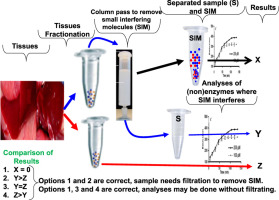Ecotoxicology and Environmental Safety ( IF 6.8 ) Pub Date : 2018-02-01 , DOI: 10.1016/j.ecoenv.2018.01.051 Biswaranjan Paital

|
For biochemical assay of every enzyme including redox regulatory enzymes, any interfering small molecules (ISM) that may cross react with substrates or indirectly influence the reaction, must be removed. Such ISM(s) if present, need to be either neutralized or filtered out both from the sample or from the reaction mixture. This is a standard protocol adapted worldwide and fundamental rule in biochemistry. Without such approach, results obtained from a study that includes enzymatic assays seem to be inaccurate. Such inaccuracy raises question on the use of such data in future, especially as ecotoxic biomarkers. Tissue specific seasonal variation in natural titre of such ISM(s) in organisms leads to give rise counterfeit results. Such a case is highlighted in this correspondence article in relation to assay of redox regulatory enzymes including superoxide dismutase, catalase, especially the enzymes of glutathione system in presence of glutathione (GSH) in sample. This fact is discussed considering a recent publication doi.org/10.1016/j.ecoenv.2017.03.056 in which the authors have measured glutathione enzymes in tissues without removing GSH, that acts as ISM, from the sample. It is inferred that logical and sound scientific practices need to be followed for measuring biochemical activity of all enzymes in general and enzymes of glutathione system in particular. The main objective of this article was to make an alert in scientific society to avoid such mistakes in future.
中文翻译:

去除小的非酶分子,用于氧化还原调节酶的生化分析;关于“铅暴露下牡蛎Crassostrea madrasensis(Preston)的g和消化腺的抗氧化反应的示例性评论。
为了对每种酶(包括氧化还原调节酶)进行生化分析,必须去除可能与底物发生交叉反应或间接影响反应的任何干扰小分子(ISM)。如果存在,则需要从样品或反应混合物中中和或滤除此类ISM。这是在世界范围内适用的标准协议,也是生物化学中的基本规则。如果没有这种方法,从包括酶促测定在内的研究中获得的结果似乎是不准确的。这种不准确性使人们对将来使用此类数据(尤其是作为生态毒性生物标记物)的使用提出了质疑。生物体内此类ISM天然滴度的组织特定季节性变化导致产生假冒结果。这种情况在这篇通讯文章中特别涉及在样品中存在谷胱甘肽(GSH)的情况下有关氧化还原调节酶(包括超氧化物歧化酶,过氧化氢酶,尤其是谷胱甘肽系统酶)的测定。考虑到最近的出版物doi.org/10.1016/j.ecoenv.2017.03.056讨论了这个事实,在该出版物中,作者测量了组织中的谷胱甘肽酶,但未从样品中去除充当ISM的GSH。推断需要遵循逻辑和合理的科学实践来测量所有酶的生物化学活性,特别是谷胱甘肽系统的酶。本文的主要目的是在科学社会中发出警报,以防止将来发生此类错误。尤其是样品中存在谷胱甘肽(GSH)时的谷胱甘肽系统酶。考虑到最近的出版物doi.org/10.1016/j.ecoenv.2017.03.056讨论了这个事实,在该出版物中,作者测量了组织中的谷胱甘肽酶,但未从样品中去除充当ISM的GSH。推断需要遵循逻辑和合理的科学实践来测量所有酶的生物化学活性,特别是谷胱甘肽系统的酶。本文的主要目的是在科学社会中发出警报,以防止将来发生此类错误。尤其是样品中存在谷胱甘肽(GSH)时的谷胱甘肽系统酶。考虑到最近的出版物doi.org/10.1016/j.ecoenv.2017.03.056讨论了这个事实,在该出版物中,作者测量了组织中的谷胱甘肽酶,但未从样品中去除充当ISM的GSH。推断需要遵循逻辑和合理的科学实践来测量所有酶的生物化学活性,特别是谷胱甘肽系统的酶。本文的主要目的是在科学社会中发出警报,以防止将来发生此类错误。推断需要遵循逻辑和合理的科学实践来测量所有酶的生物化学活性,特别是谷胱甘肽系统的酶。本文的主要目的是在科学社会中发出警报,以防止将来发生此类错误。推断需要遵循逻辑和合理的科学实践来测量所有酶的生物化学活性,特别是谷胱甘肽系统的酶。本文的主要目的是在科学社会中发出警报,以防止将来发生此类错误。



























 京公网安备 11010802027423号
京公网安备 11010802027423号